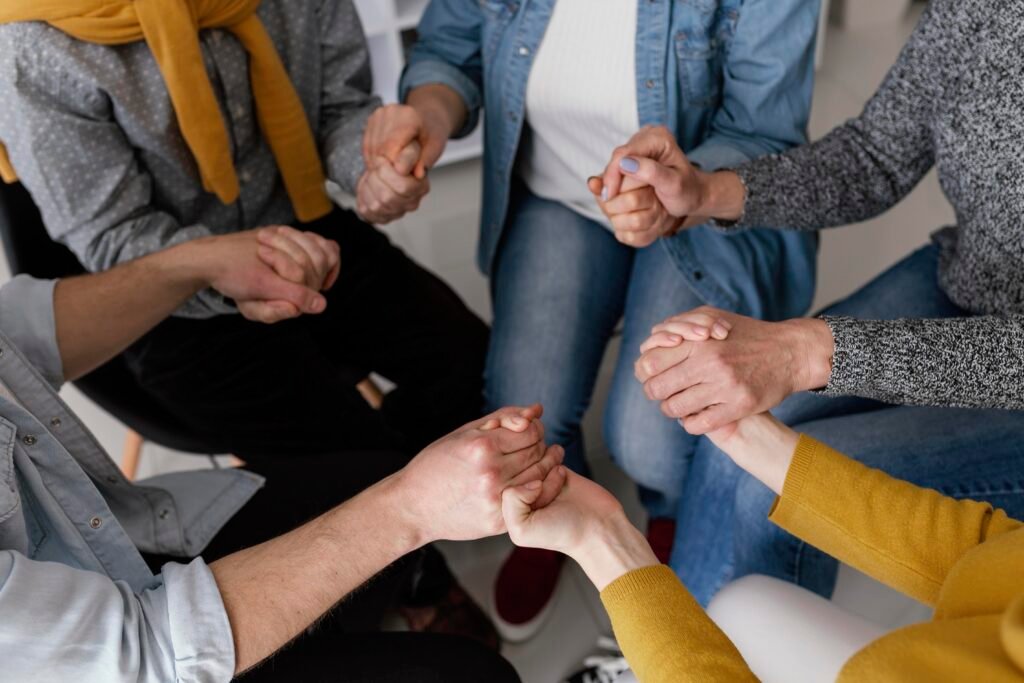The Foundations of Spiritual Community
At its core, a spiritual community is more than just a group of like-minded individuals. It’s a living, breathing ecosystem of growth, support, and transformation. When we come together with intention and openness, we create a powerful field of collective consciousness that can elevate everyone involved.
This synergistic effect is often described as a “group field” or “collective energy.” It’s a phenomenon where the whole becomes greater than the sum of its parts. In a spiritual community, this manifests as a palpable sense of energy, heightened awareness, and accelerated personal growth that participants often report experiencing.
The power of spiritual community lies in its ability to:
- Amplify individual practices – Group meditation, prayer, or energy work can intensify the experience for all participants.
- Provide diverse perspectives – Each member brings unique insights, challenging and expanding our own understanding.
- Offer emotional and spiritual support – Sharing our journey with others who understand can be profoundly healing.
- Create accountability – Community involvement often motivates us to maintain our spiritual practices more consistently.
- Foster a sense of belonging – In a world that can feel fragmented, spiritual communities offer a place of connection and shared purpose.
Ancient wisdom traditions have long recognized this power. From Buddhist sanghas to Christian congregations, spiritual communities have been integral to human spiritual development for millennia. Today, we’re rediscovering and reimagining these connections for our modern world.
The concept of spiritual community is deeply rooted in human history. In many indigenous cultures, the entire tribe or village functioned as a spiritual community, with rituals and practices woven into daily life. As civilizations developed, more formalized spiritual communities emerged:
- In Buddhism, the sangha (community of practitioners) is considered one of the Three Jewels, alongside the Buddha and the dharma (teachings).
- Sufi orders in Islam have long emphasized the importance of spiritual companionship (suhbah) for growth on the mystical path.
- Christian monastic communities have served as centres of spiritual practice and learning for centuries.
- In Hindu traditions, ashrams have provided spaces for seekers to come together for intensive spiritual practice and study.

These traditional models offer valuable insights, but today’s spiritual communities are evolving to meet the needs of our contemporary world. Some key developments include:
- Interfaith and eclectic communities – Many modern spiritual groups draw from multiple traditions, fostering a more inclusive and diverse approach.
- Integration of science and spirituality – Some communities are incorporating findings from neuroscience, psychology, and quantum physics into their practices.
- Social and environmental activism – Many spiritual communities now see engagement with social and ecological issues as an integral part of their spiritual practice.
- Virtual and hybrid models – Online platforms and digital tools are enabling new forms of spiritual connection that transcend geographical boundaries.
- Emphasis on practical application – There’s a growing focus on integrating spiritual insights into everyday life, work, and relationships.
As we navigate the complexities of the 21st century, spiritual communities offer a vital source of connection, meaning, and transformation. They remind us that while our spiritual journey is deeply personal, it need not be solitary. By coming together in community, we can support each other’s growth, amplify our collective wisdom, and contribute to the healing and awakening of our world.
The Neuroscience of Connection
Recent neuroscientific research has shed light on why community is so impactful in our spiritual journeys. When we engage in meaningful connections with others, our brains release neurochemicals like oxytocin and serotonin, which not only make us feel good but also enhance our capacity for empathy and spiritual experiences.
Curious fact: Studies using fMRI scans have shown that group meditation can synchronize brain activity among participants, potentially amplifying the meditative state for everyone involved.
Overcoming Isolation in the Spiritual Journey
Many spiritual seekers experience periods of isolation or loneliness, especially as they begin to shift their perspectives and priorities. This is where community becomes crucial. By connecting with others who understand our experiences, we can:
- Validate our experiences and insights
- Share resources and practices
- Provide emotional support during challenging times
- Celebrate milestones and breakthroughs together
Practical advice: Create a “spiritual buddy” system within your community. Check-in with your buddy regularly, sharing your insights, challenges, and progress. This ongoing connection can provide continuity and support between group gatherings.
The Role of Mentorship and Guidance
Within a spiritual community, we often find individuals who are further along the path and can offer guidance. These mentors or teachers can provide invaluable insights, helping us navigate the complexities of spiritual growth.
However, it’s important to approach mentorship with discernment. As the Buddha advised, “Be a lamp unto yourself.” Use the guidance of others to illuminate your path, but always trust your inner wisdom.
Cultivating Healthy Community Dynamics
For a spiritual community to thrive, it needs to foster an environment of trust, respect, and open communication. Here are some principles to cultivate:
- Non-judgment: Create a space where all experiences and perspectives are welcomed without criticism.
- Active listening: Practice deep, empathetic listening to truly understand others.
- Authenticity: Encourage honest sharing, even of struggles and doubts.
- Boundaries: Respect individual needs for space and privacy.
- Conflict resolution: Develop healthy ways to address disagreements when they arise.
Ego Challenges in Community Settings
As we engage more deeply in the community, our egos may feel threatened. Common ego reactions include:
- Comparison and competition
- Fear of vulnerability
- Desire for approval or recognition
- Resistance to change or new ideas
To calm these ego responses:
- Practice self-compassion – Acknowledge your feelings without judgment.
- Use mindfulness – Observe ego reactions without identifying with them.
- Reframe challenges – See difficulties as opportunities for growth.
- Share openly – Discussing ego challenges in the group can diminish their power.
Expanding Your Spiritual Network
While having a core spiritual community is valuable, don’t limit yourself. Explore different groups, traditions, and practices to broaden your perspective. This diversity can enrich your spiritual journey and prevent stagnation.
Practical advice: Organize or attend interfaith events or multi-tradition retreats. These experiences can expand your understanding and foster a sense of global spiritual community.

The Digital Revolution in Spiritual Community
The internet has revolutionized how we connect spiritually. Online platforms offer unprecedented access to teachings, practices, and communities from around the world. Some innovative ways to engage include:
- Virtual reality meditation spaces
- Live-streamed ceremonies and rituals
- Online study groups for sacred texts
- Global prayer and intention-setting events
While digital connections are powerful, remember to balance them with in-person interactions when possible. There’s a unique energy in physical presence that can’t be fully replicated online.
Integrating Community Insights into Daily Life
The true test of our spiritual growth often comes in our day-to-day lives. How can we take the insights and energy from our spiritual community and use them in our relationships, work, and personal practices?
- Set intentions – Before leaving a community gathering, set clear intentions for how to apply what you’ve learned.
- Journal – Reflect on your community experiences and how they relate to your daily life.
- Practice mindfulness – Use mindfulness techniques to bring community-cultivated awareness into everyday moments.
- Share your journey – Don’t hesitate to share your spiritual insights with friends and family outside your spiritual community.
The Ripple Effect of Communal Awakening
As we engage in spiritual community, we’re not just transforming ourselves – we’re contributing to a larger shift in collective consciousness. Each interaction, each shared insight, each moment of support ripples outward, touching lives far beyond our immediate circle.
By embracing the power of community in our spiritual journeys, we open ourselves to exponential growth and profound connection. We remember that while the path of awakening is deeply personal, we need not walk it alone. In the words of spiritual teacher Ram Dass, “We’re all just walking each other home.”
Whether you’re seeking to deepen your existing spiritual connections or looking to find your spiritual tribe, remember that the community you seek is also seeking you. Open your heart, extend your hand, and step into the transformative power of spiritual community.




